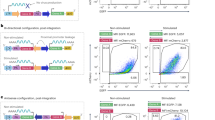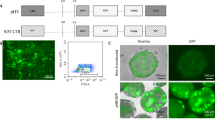Abstract
Gene-transfer vectors based on lentiviruses are distinguished by their ability to transduce non-dividing cells1,2. The HIV-1 proteins Matrix, Vpr and Integrase have been implicated in the nuclear import of the viral genome in non-dividing cells3,4,5. Here we show that a sequence within pol is also required in cis. It contains structural elements previously associated with the progress of reverse transcription in target cells6,7,8,9. We restored these elements in cis within late-generation lentiviral vectors10,11. The new vector transduced to a much higher efficiency several types of human primary cells, when both growing and growth-arrested, including haematopoietic stem cells assayed by long-term repopulation of NOD/SCID mice. On in vivo administration into SCID mice, the vector induced higher plasma levels of human clotting factor IX (F.IX) than non-modified vector. Our results indicate that nuclear translocation of the genome is a rate-limiting step in lentiviral infection of both dividing and non-dividing cells, and that it depends on protein and nucleic acid sequence determinants. Full rescue of this step in lentivirus-based vectors improves performance for gene-therapy applications.
This is a preview of subscription content, access via your institution
Access options
Subscribe to this journal
Receive 12 print issues and online access
$209.00 per year
only $17.42 per issue
Buy this article
- Purchase on Springer Link
- Instant access to full article PDF
Prices may be subject to local taxes which are calculated during checkout





Similar content being viewed by others
References
Naldini, L. et al. In vivo gene delivery and stable transduction of nondividing cells by a lentiviral vector. Science 272, 263–267 (1996).
Naldini, L. Lentiviruses as gene transfer agents for delivery to non-dividing cells. Curr. Opin. Biotechnol. 9, 457–463 (1998).
Bukrinsky, M.I. et al. A nuclear localization signal within HIV-1 matrix protein that governs infection of non-dividing cells. Nature 365, 666–669 (1993).
Gallay, P., Swingler, S., Aiken, C. & Trono, D. HIV-1 infection of nondividing cells: C-terminal tyrosine phosphorylation of the viral matrix protein is a key regulator. Cell 80, 379–388 (1995).
Popov, S. et al. Viral protein R regulates nuclear import of the HIV-1 pre-integration complex. EMBO J. 17, 909–917 (1998).
Charneau, P., Alizon, M. & Clavel, F. A second origin of DNA plus-strand synthesis is required for optimal human immunodeficiency virus replication. J. Virol. 66, 2814–2820 (1992).
Charneau, P. et al. HIV-1 reverse transcription. A termination step at the center of the genome. J. Mol. Biol. 241, 651–662 (1994).
Ilyinskii, P.O. & Desrosiers, R.C. Identification of a sequence element immediately upstream of the polypurine tract that is essential for replication of simian immunodeficiency virus. EMBO J. 17, 3766–3774 (1998).
Powell, M.D. & Levin, J.G. Sequence and structural determinants required for priming of plus-strand DNA synthesis by the human immunodeficiency virus type 1 polypurine tract. J. Virol. 70, 5288–5296 (1996).
Zufferey, R. et al. Self-inactivating lentivirus vector for safe and efficient in vivo gene delivery. J. Virol. 72, 9873–9880 (1998).
Zufferey, R., Nagy, D., Mandel, R.J., Naldini, L. & Trono, D. Multiply attenuated lentiviral vector achieves efficient gene delivery in vivo. Nature Biotechnol. 15, 871–875 (1997).
Dull, T. et al. A third-generation lentivirus vector with a conditional packaging system. J. Virol. 72, 8463–8471 (1998).
Lewis, P., Hensel, M. & Emerman, M. Human immunodeficiency virus infection of cells arrested in the cell cycle. EMBO J. 11, 3053–3058 (1992).
Nie, Z. et al. The putative α helix 2 of human immunodeficiency virus type 1 Vpr contains a determinant which is responsible for the nuclear translocation of proviral DNA in growth-arrested cells. J. Virol. 72, 4104–4115 (1998).
Kiernan, R.E., Ono, A., Englund, G. & Freed, E.O. Role of matrix in an early postentry step in the human immunodeficiency virus type 1 life cycle. J. Virol. 72, 4116–4126 (1998).
Schmidtmayerova, H., Alfano, M., Nuovo, G. & Bukrinsky, M. Human immunodeficiency virus type 1 T-lymphotropic strains enter macrophages via a CD4- and CXCR4-mediated pathway: replication is restricted at a postentry level. J. Virol. 72, 4633–4642 (1998).
Hansen, M.S. et al. Integration complexes derived from HIV vectors for rapid assays in vitro. Nature Biotechnol. 17, 578–582 (1999).
Miller, M.D., Farnet, C.M. & Bushman, F.D. Human immunodeficiency virus type 1 preintegration complexes: studies of organization and composition. J. Virol. 71, 5382–5390 (1997).
Akkina, R.K. et al. High-efficiency gene transfer into CD34+ cells with a human immunodeficiency virus type 1-based retroviral vector pseudotyped with vesicular stomatitis virus envelope glycoprotein G. J. Virol. 70, 2581–2585 (1996).
Case, S.S. et al. Stable transduction of quiescent CD34(+)CD38(−) human hematopoietic cells by HIV-1-based lentiviral vectors. Proc. Natl Acad. Sci. USA 96, 2988–2993 (1999).
Miyoshi, H., Smith, K.A., Mosier, D.E., Verma, I.M. & Torbett, B.E. Transduction of human CD34+ cells that mediate long-term engraftment of NOD/SCID mice by HIV vectors. Science 283, 682–686 (1999).
Uchida, N. et al. HIV, but not murine leukemia virus, vectors mediate high efficiency gene transfer into freshly isolated G0/G1 human hematopoietic stem cells. Proc. Natl Acad. Sci. USA 95, 11939–11944 (1998).
Sutton, R.E., Wu, H.T., Rigg, R., Bohnlein, E. & Brown, P.O. Human immunodeficiency virus type 1 vectors efficiently transduce human hematopoietic stem cells. J. Virol. 72, 5781–5788 (1998).
Conneally, E., Eaves, C.J. & Humphries, R.K. Efficient retroviral-mediated gene transfer to human cord blood stem cells with in vivo repopulating potential. Blood 91, 3487–3493 (1998).
Marandin, A. et al. Retrovirus-mediated gene transfer into human CD34+38low primitive cells capable of reconstituting long-term cultures in vitro and nonobese diabetic-severe combined immunodeficiency mice in vivo. Hum. Gene Ther. 9, 1497–1511 (1998).
Kay, M.A. & High, K. Gene therapy for the hemophilias. Proc. Natl Acad. Sci. USA 96, 9973–9975 (1999).
Andreadis, S.T., Brott, D., Fuller, A.O. & Palsson, B.O. Moloney murine leukemia virus-derived retroviral vectors decay intracellularly with a half-life in the range of 5.5 to 7.5 hours. J. Virol. 71, 7541–7548 (1997).
Schwartz, O., Marechal, V., Friguet, B., Arenzana-Seisdedos, F. & Heard, J.M. Antiviral activity of the proteasome on incoming human immunodeficiency virus type 1. J. Virol. 72, 3845–3850 (1998).
Charneau, P. & Clavel, F. A single-stranded gap in human immunodeficiency virus unintegrated linear DNA defined by a central copy of the polypurine tract. J. Virol. 65, 2415–2421 (1991).
Bukrinskaya, A., Brichacek, B., Mann, A. & Stevenson, M. Establishment of a functional human immunodeficiency virus type 1 (HIV-1) reverse transcription complex involves the cytoskeleton. J. Exp. Med. 188, 2113–2125 (1998).
Acknowledgements
We thank W. Piacibello, F. Bussolino and members of their laboratories for help in setting up experiments with haematopoietic cells and endothelial cells, respectively; and T. Dull, M. Kelly and M. Gasmi for providing constructs. The financial support of Telethon–Italy (grant A.143 to L.N.) and MURST (Grant 9905313431 to LN) is gratefully acknowledged.
Author information
Authors and Affiliations
Corresponding author
Rights and permissions
About this article
Cite this article
Follenzi, A., Ailles, L., Bakovic, S. et al. Gene transfer by lentiviral vectors is limited by nuclear translocation and rescued by HIV-1 pol sequences. Nat Genet 25, 217–222 (2000). https://doi.org/10.1038/76095
Received:
Accepted:
Issue Date:
DOI: https://doi.org/10.1038/76095
This article is cited by
-
Neuropilin 1 and its inhibitory ligand mini-tryptophanyl-tRNA synthetase inversely regulate VE-cadherin turnover and vascular permeability
Nature Communications (2022)
-
The TFEB-TGIF1 axis regulates EMT in mouse epicardial cells
Nature Communications (2022)
-
Development of SARS-CoV2 humoral response including neutralizing antibodies is not sufficient to protect patients against fatal infection
Scientific Reports (2022)
-
Role of TGFβ1 and WNT6 in FGF2 and BMP4-driven endothelial differentiation of murine embryonic stem cells
Angiogenesis (2022)
-
TFEB controls integrin-mediated endothelial cell adhesion by the regulation of cholesterol metabolism
Angiogenesis (2022)



